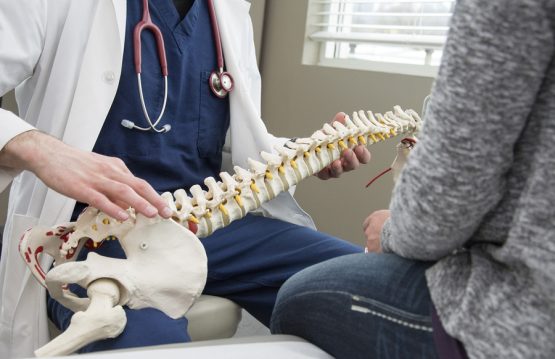Spinal fracture at the thoracic (dorsal) or lumbar level occurs most frequently following a trauma of medium and high strength (fall from another level, road accident, etc.). The production mechanism is flexion, extension, rotation, compression or combined. The most common location is the transition area between the thoracic and lumbar spine (D12-L1).
CONTENT:
What causes a spinal fracture?
Spinal fracture is often the consequence of severe physical trauma, such as that caused by a car accident, a fall into a void, or a severe blow to the cervical area. Cervical spine fracture can also be caused by certain conditions, such as osteoporosis, bone cancer, an infection, or various inflammatory or autoimmune diseases.
A fracture in the vertebrae of the cervical spine can have very serious consequences, such as paralysis. neck down (tetraplegia), brachial paresis or even death. The spine is divided into three segments – lumbar (5 vertebrae), thoracic (12 vertebrae) and cervical (7 vertebrae) – and consists of 33 vertebrae and numerous discs, ligaments and muscles, which have the role of protecting and ensure flexibility and stability.
The most exposed segment to the traumatic action of external factors in case of a trauma is the cervical spine.
The causes of cervical spine fractures involve severe neck injuries, which occur against the background of a strong blow (athletes who practice rugby, football, skiing or boxing are more exposed to this type of blow), a fall (from a height, in a pelvis). with shallow water, on a bicycle) or a car accident (hitting the steering wheel, for example).
What are the symptoms of a spinal fracture?
Cervical spine fracture can have various symptoms, depending on the affected vertebra and the severity and extent of the lesion. The most common symptoms of cervical spine fracture are:
- Pain at the fracture site (starts at the neck and reaches the shoulders and arms)
- Swelling
- Stiff neck
- Bruising
- Muscle weakness in the neck, torso or lower or upper limbs
- Reduced mobility
- Balance disorders
- Difficulty walking
- Numbness or paralysis of the limbs
What is the treatment of a spinal fracture?
The treatment of a cervical spine fracture depends on the vertebra that was injured and the severity of the condition. A minor fracture can be healed by immobilizing the neck with a cervical collar, until the “welding” of the damaged bones, about 6-8 weeks. Analgesics may be recommended to relieve pain, and special exercises recommended by a physiotherapist are indicated to speed healing.
In case of a severe fracture, the doctor may consider surgery, performed under general anesthesia, which aims to decompress the affected bone marrow and nerve roots, physiological realignment of the spine and stabilize the fracture focus.
There are two surgical techniques for cervical spine fracture:
Anterior cervical approach – this procedure has complications such as local hematoma, difficulty swallowing or hoarseness, but disappear within a maximum of one month after surgery.
Posterior cervical approach – this procedure has fewer risks (local hematoma is the most common complication) and involves the implantation of screws in the vertebra above and below the fractured one, which will be connected on each side with titanium bars. Restoration of bone bridges occurs in 10-12 weeks, during which time the patient must avoid large and sudden movements of the head and neck. Neurosurgical control and computed tomography at the end of the recovery period are also recommended.


